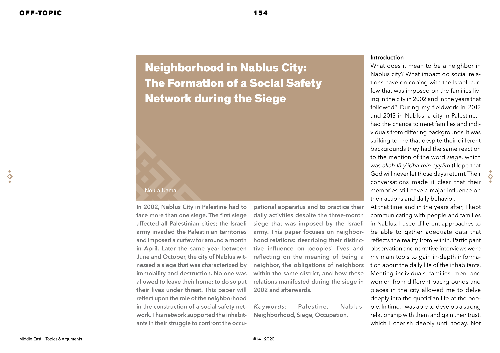Neighborhood in Nablus City: The Formation of a Social Safety Network during the Siege
In 2002, Nablus City in Palestine had to face more than one siege. The first siege affected all Palestinian cities; the Israeli army invaded the Palestinian territories and imposed a curfew for around a month in April. Later the same year between June and October, the city of Nablus witnessed a sieg...
Gardado en:
| Publicado en: | Middle East - Topics & Arguments |
|---|---|
| Autor Principal: | |
| Formato: | Artikel (Zeitschrift) |
| Idioma: | inglés |
| Publicado: |
Philipps-Universität Marburg
2020
|
| Schlagworte: | |
| Acceso en liña: | Acceso en liña |
| Tags: |
Engadir etiqueta
Sen Etiquetas, Sexa o primeiro en etiquetar este rexistro!
|
| Zusammenfassung: | In 2002, Nablus City in Palestine had to face more than one siege. The first siege affected all Palestinian cities; the Israeli army invaded the Palestinian territories and imposed a curfew for around a month in April. Later the same year between June and October, the city of Nablus witnessed a siege that was characterized by immobility and destruction. No one was allowed to leave their home; to do so put their lives under threat. This paper will reflect upon the role of the neighborhood in the construction of a social safety network. This network supported the inhabitants in their struggle to confront the occupational apparatus and to practice their daily activities despite the three-month siege that was imposed by the Israeli army. This paper focuses on neighborhood relations: describing their distinctive influence on peoples’ lives and reflecting on the meaning of being a neighbor, the obligations of neighbors within the same district, and how these relations manifested during the siege in 2002 and afterwards. |
|---|---|
| DOI: | 10.17192/meta.2020.14.8254 |
 Publikationsserver
Publikationsserver